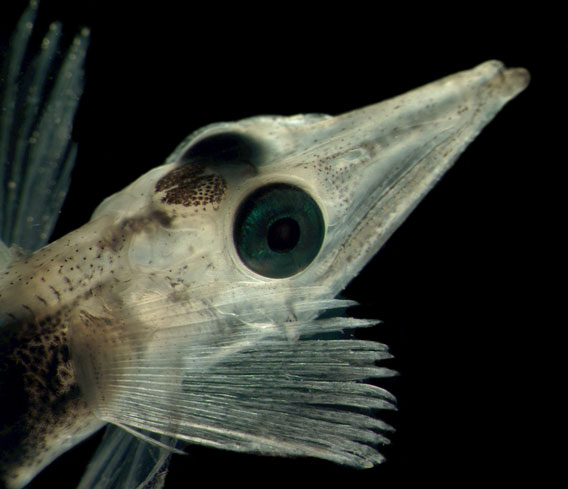An Evolutionary Key
The thin-boned icefish could help scientists solve the riddle of osteopenia, a precursor to osteoporosis
By Jacqueline Mitchell
In the icy waters of the Antarctic, icefish have taken their own Darwinian journey, developing novel biological solutions to their changing environment. The Tufts developmental biologist Pamela C. Yelick and her colleagues at three other universities are optimistic that the genetic machinations of the icefish could shed light on what causes human osteopenia—a precursor to the brittle-bone disease osteoporosis—and how to arrest it.

Understanding the genetic machinations of the prehistoric-looking icefish could lead to a treatment for osteopenia in humans. Photo: Russ Hopcroft, University of Alaska, Fairbanks, and Census of Marine Life
Millions of years ago, the Antarctic Ocean was not the unforgiving, frigid ecosystem we know today but a temperate habitat that was home to many species of fish. Back then, icefish species lived on the sea floor, an environment to which they had adapted so completely that they lost their swim bladder, an organ that regulates buoyancy in most other kinds of fish.
But about 34 million years ago, a combination of atmospheric and geologic conditions caused the Antarctic water temperature to drop about 41 degrees Fahrenheit, to below zero. It happened over a course of just a few million years—a blink of an eye in evolutionary terms. When other fish species died out or migrated to warmer waters, the bottom-dwelling icefish were poised to exploit the newly vacated ocean feeding grounds. The only problem was that since they lacked swim bladders, they simply couldn’t get to a lot of the food.
That problem was solved through evolution. Over the course of about 4 million years, the spiny, prehistoric-looking icefish shed bone density—so much so that you can make out the shape of their organs through their fragile skeletons. The genetic adaptation allowed the former bottom dwellers to swim and feed higher up in the ocean’s water column. At the same time, different icefish species—like Darwin’s finches—developed specialized jaw and facial morphology to exploit the new kinds of prey available to them.
Yelick, G89, a professor of oral and maxillofacial pathology at the School of Dental Medicine, and her collaborators—H. William Detrich, a biochemist at Northeastern University; R. Craig Albertson, a biologist at Syracuse University; and University of Oregon neuroscientist John Postlethwait—are investigating the demineralization of the icefish skeleton as a model for osteopenia. Funded by a $2.48 million, five-year grant from the National Institutes of Health, the researchers hope to identify the genes that control bone density in the icefish. They suspect the same genes also regulate bone density in humans.
A Better Model
“The evolution of this decreased bone density is analogous to the development of osteopenia over a human lifetime,” says Yelick, who directs the dental school’s Division of Craniofacial and Molecular Genetics and is a member of the Sackler School’s Genetics Program and its Cell, Molecular and Developmental Biology Program. “You can use these slow evolutionary changes to study changes that might occur in a human lifetime,” she told the journal Nature.
Studying icefish should reveal more about the genetic and molecular aspects of osteopenia in humans than the traditional scientific methodology of examining mice that are genetically manipulated to develop thinning bones. The increase in knowledge cannot come too soon: osteopenia affects an estimated 34 million women and 12 million men in the United States, and the disease often leads to the more crippling osteoporosis.
The four researchers, who met at a conference on zebrafish two years ago, are looking at craniofacial development in the embryos of two species of icefish—the blackfin icefish and the Antarctic silverfish.
So far Yelick’s team has found that icefish develop thinner, lighter skeletons mainly through a trick of genetic timing. Compared with their relatives—the freshwater three-spined stickleback and the zebrafish—icefish have an unusual pattern of gene expression. Genes that trigger bone growth are “switched on” relatively briefly, while those that build cartilage remain activated for a more prolonged period.
“If we can learn to manipulate these [genetic] pathways, we could identify novel targets for drugs for eventual use in humans,” says Yelick.
Jacqueline Mitchell can be reached at jacqueline.mitchell@tufts.edu.


